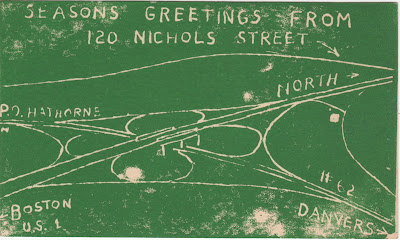My father liked to design Christmas cards for our family, and often his design was printed on one side of a 1-cent postcard. Here are some examples. These were saved by my cousin Janet Derouin and sent to me THIS month as a delightful surprise with her own Christmas card and letter. Thank you Janet! I well remember some of these, but others seem new to me. I was too young, or not paying attention to the cards my parents were sending out.
This green one with the map is a fun surprise. No date on it, but I know that the cloverleaf was constructed during my first-grade year (1949-50), so I'd guess that this might have been made for December 1950. The little white square on the right side locates our house, 120 Nichols Street, Danvers. My father was good at sketching maps and plans. He also always printed his letters, rather than writing in cursive.
Below is another undated postcard that I have never seen. I do recall posing for that photograph. We climbed up the ladder and stood still while various photos were taken. Somewhere I have copies of several versions of that scene, and I knew that the purpose of the posing was for a Christmas card. But until this week I have not seen (or don't recall seeing) the finished product. Our dog Heidi is included. Getting her to pose, too, was probably a challenge; it looks like she was about to walk away. I'm delighted to have this little card from the past.
Christmas Greetings to all, and Best Wishes for a Happy New Year!








